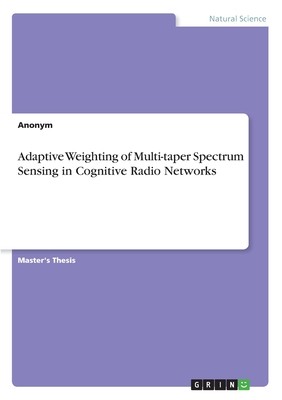
- We will send in 10–14 business days.
- Author: Anonym
- Publisher: GRIN Verlag
- Year: 2020
- Pages: 152
- ISBN-10: 3346133133
- ISBN-13: 9783346133137
- Format: 14.8 x 21 x 0.9 cm, minkšti viršeliai
- Language: English
- SAVE -10% with code: EXTRA
Adaptive Weighting of Multi-taper Spectrum Sensing in Cognitive Radio Networks (e-book) (used book) | bookbook.eu
Reviews
Description
Master's Thesis from the year 2019 in the subject Mathematics - Applied Mathematics, grade: Master Degree, language: English, abstract: This thesis discusses the performance enhancement of multi-taper spectrum sensing as a powerful technique for cognitive radio networks. In multi-taper spectrum sensing, regular detection of unused spectrum holes is performed to make cognitive radio networks aware of users' ctivities. As a result, more effective spectrum management is expected and unlicensed users could use unused spectrum holes. In this thesis, an analytical study was proposed in which reliable, simple, and computationally efficient mathematical expressions for the mean and variance of the probability density function (PDF) of the multitaper spectrum sensing techniques were derived. The proposed analytical study was evaluated by intensive simulations using MATLAB. The presence of Additive White Gaussian Noise is assumed. Many important aspects of spectrum sensing in cognitive radio networks are included such as, receiver operating characteristics, detection rate versus signal to noise ratio (SNR), and the minimum required sample points for a specific performance. All simulations were performed to include most factors affecting the efficiency of the proposed sensing methodology such as, number of tapers (K), number of sample points (N), and the probability of false alarm (Pf). A comparison with energy detection method was done. All simulation results and comparisons confirm that the proposed model is reliable and robust under all factors considered in the simulation.
EXTRA 10 % discount with code: EXTRA
The promotion ends in 22d.18:56:43
The discount code is valid when purchasing from 10 €. Discounts do not stack.
- Author: Anonym
- Publisher: GRIN Verlag
- Year: 2020
- Pages: 152
- ISBN-10: 3346133133
- ISBN-13: 9783346133137
- Format: 14.8 x 21 x 0.9 cm, minkšti viršeliai
- Language: English English
Master's Thesis from the year 2019 in the subject Mathematics - Applied Mathematics, grade: Master Degree, language: English, abstract: This thesis discusses the performance enhancement of multi-taper spectrum sensing as a powerful technique for cognitive radio networks. In multi-taper spectrum sensing, regular detection of unused spectrum holes is performed to make cognitive radio networks aware of users' ctivities. As a result, more effective spectrum management is expected and unlicensed users could use unused spectrum holes. In this thesis, an analytical study was proposed in which reliable, simple, and computationally efficient mathematical expressions for the mean and variance of the probability density function (PDF) of the multitaper spectrum sensing techniques were derived. The proposed analytical study was evaluated by intensive simulations using MATLAB. The presence of Additive White Gaussian Noise is assumed. Many important aspects of spectrum sensing in cognitive radio networks are included such as, receiver operating characteristics, detection rate versus signal to noise ratio (SNR), and the minimum required sample points for a specific performance. All simulations were performed to include most factors affecting the efficiency of the proposed sensing methodology such as, number of tapers (K), number of sample points (N), and the probability of false alarm (Pf). A comparison with energy detection method was done. All simulation results and comparisons confirm that the proposed model is reliable and robust under all factors considered in the simulation.


Reviews